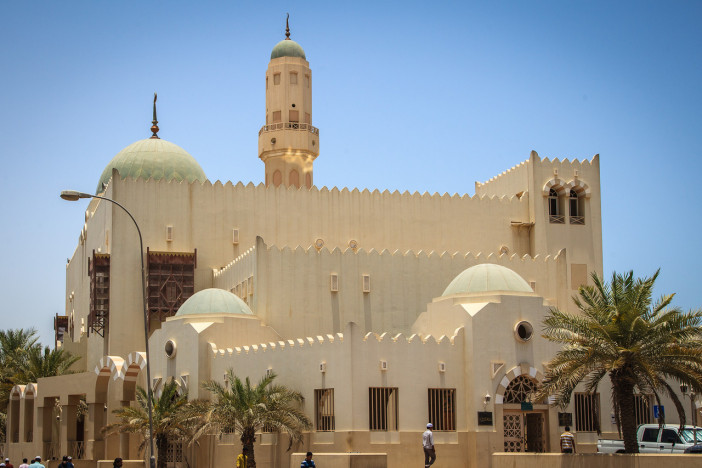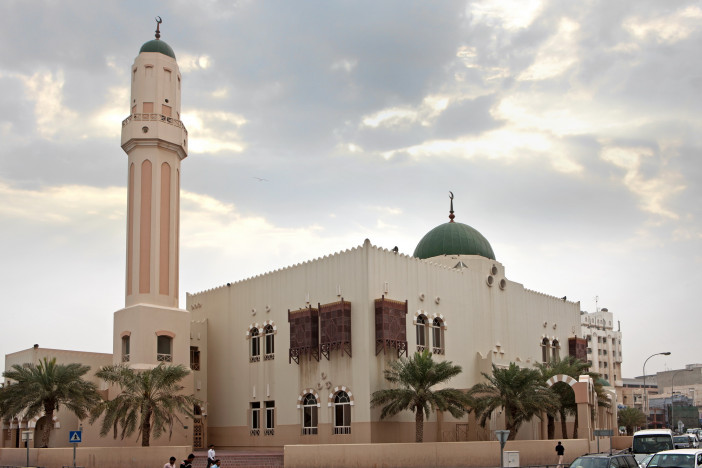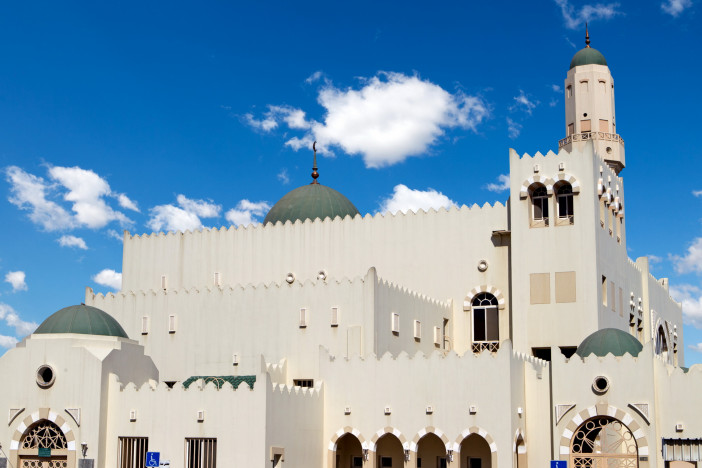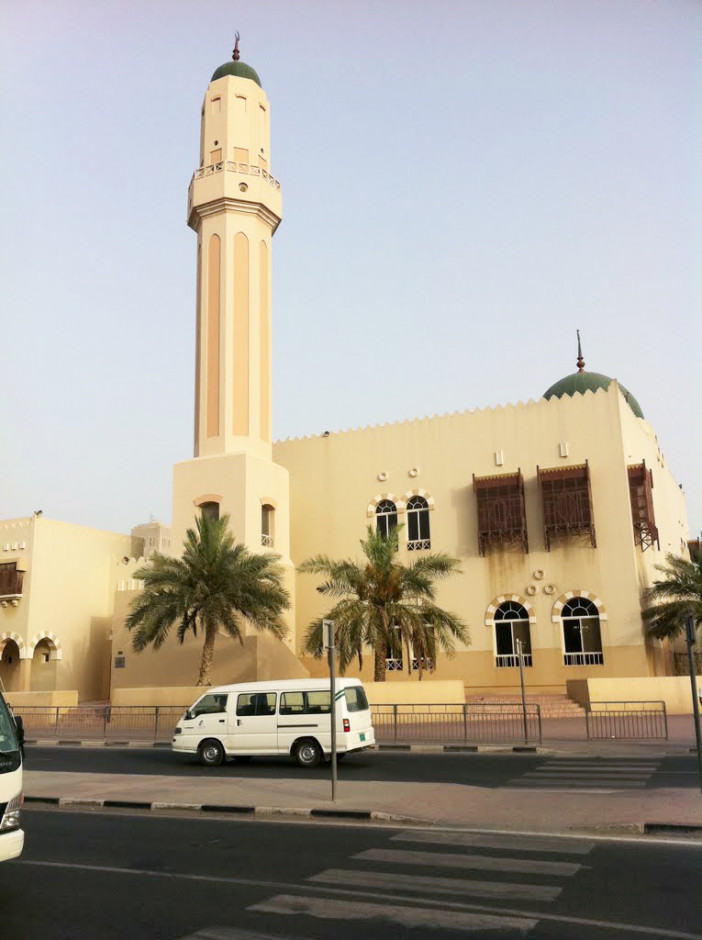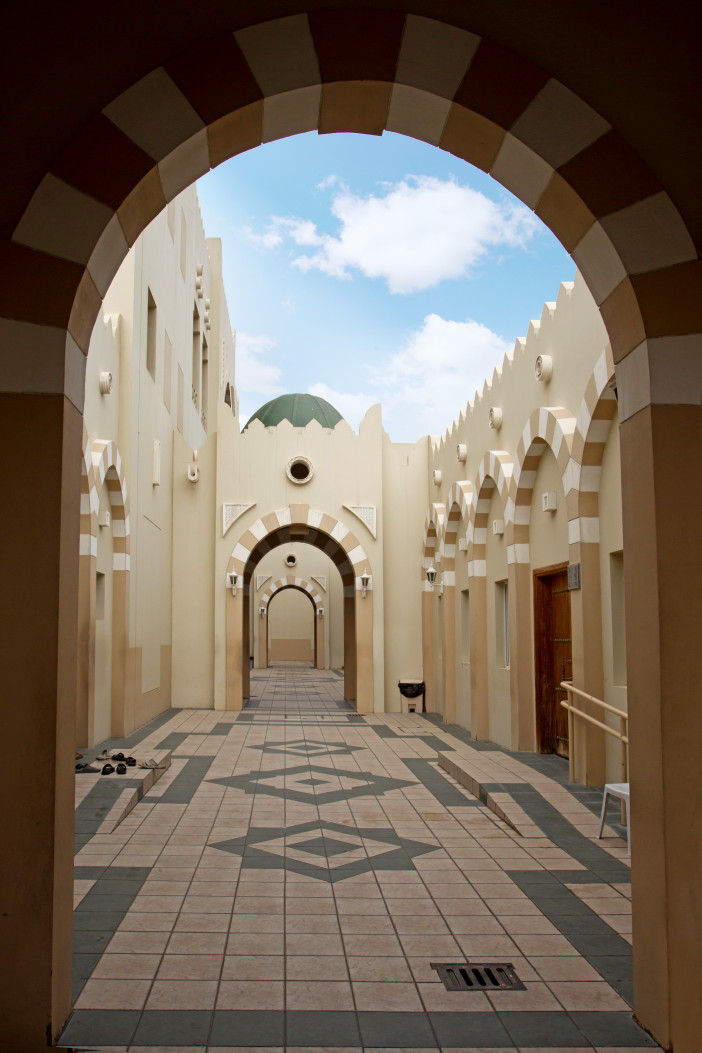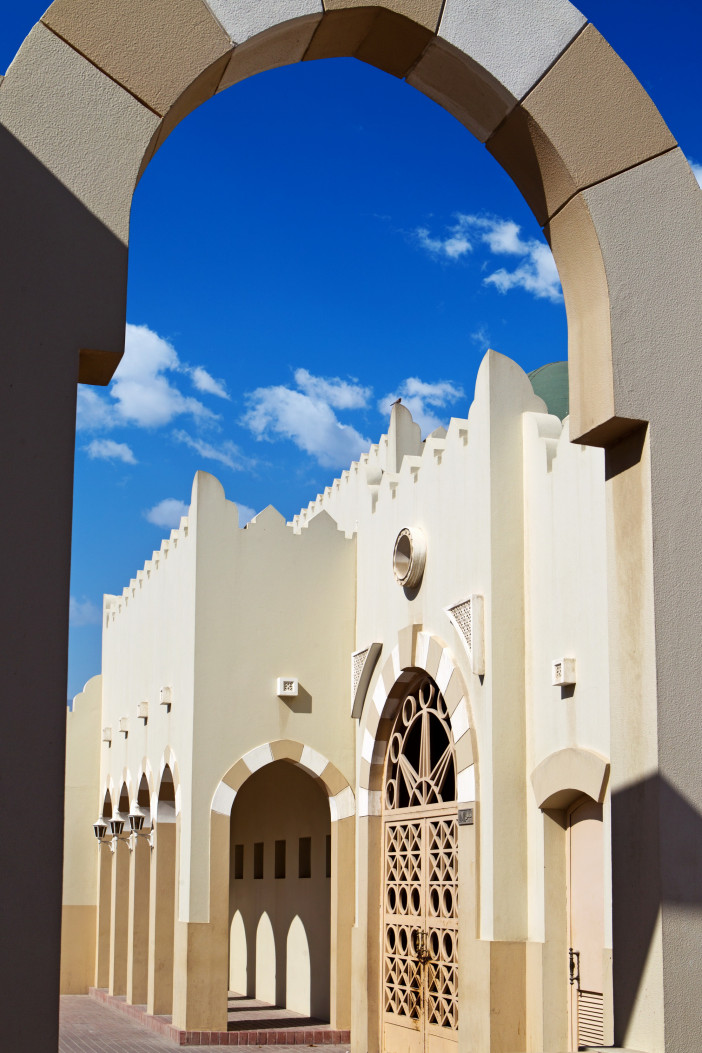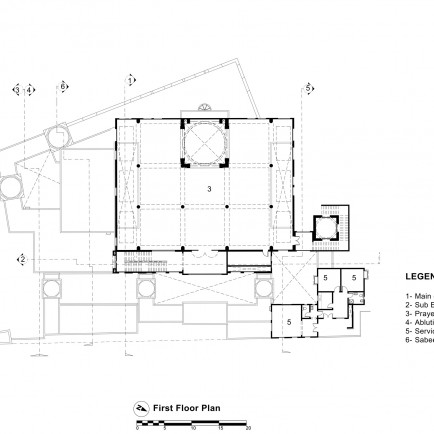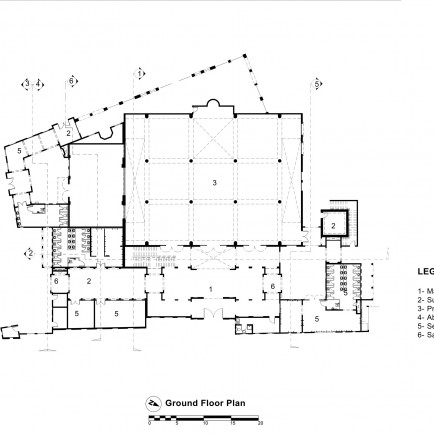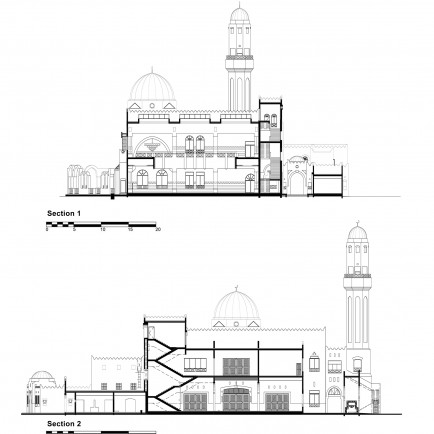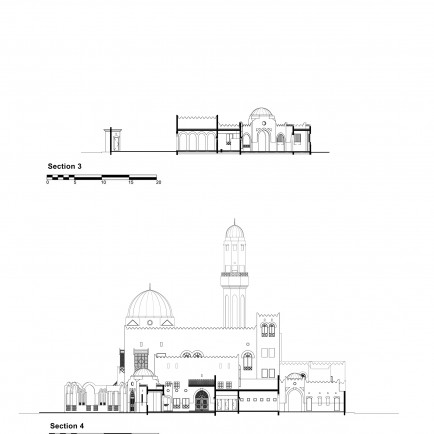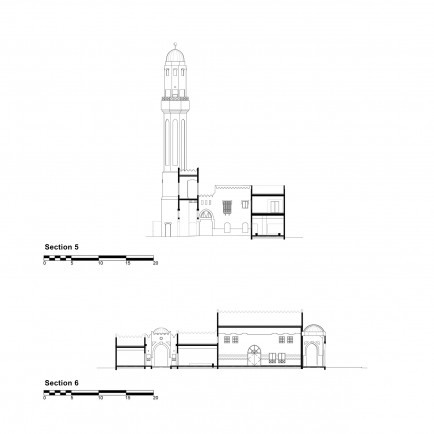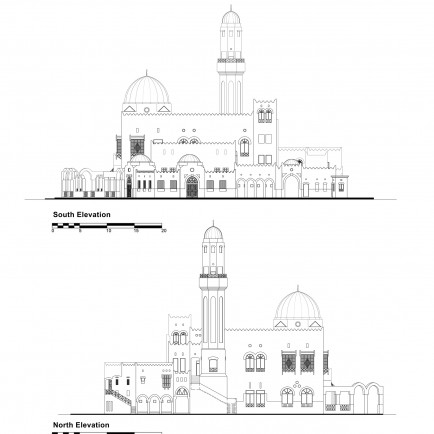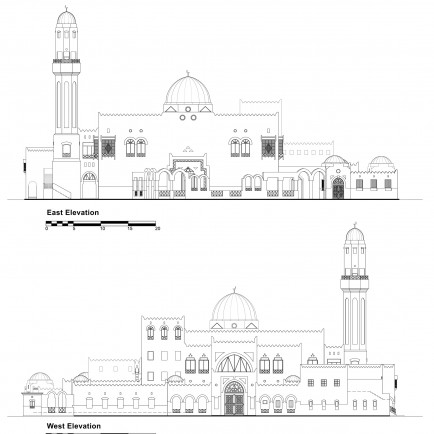Najadah Mosque
Description
Mosque Elements
The morphological components and elements of Najadah Mosque complex are the prayer hall (musalla) for both male and female prayers; the niche (mihrab or maqsarah) indicating the direction of qibla; the tower for prayers calling (the minaret), a cylindrically shaped vertical element; the ablution area, and a facility designed for ritual purification (wudu’) on two sides of the prayer hall.
the complementary components include the outdoor corridors as socio-cultural area; In addition, one significant component of the mosque is the external drinking fountains (sabeel) placed on two sides of main entrance lobby leading to prayer hall.Environmental Solution
The orientation of the masjid toward Ka’aba contributes in maximizing the daylight through the façades openings reducing the need for artificial lighting. Taking into consideration the sun orientation during high summer and deep winter seasons, masjid is strategically formed so heat gain and glare are mitigated when sunlight is excessive. The massing of the masjid and the inside outside spaces are designed in relevance to sun path as well as wind direction protecting from the dusty North wind while maximizing the building exposure to the onshore breezes. The outdoor corridors and spaces of the mosque was designed and renovated to best provide, among other functions, natural lighting and fresh air to the prayer hall.
Design Flexibility & Aesthetics of Architectural Elements
The mosque is made up of a cluster of several architectural volumes of different heights – with the minaret dominating all of them. This provides for an ever-changing image, depending on the vantage point. Its plain walls on sand nuances are punctuated with arched windows and dark wooden mashrabiya, while gentle castellated parapets stand on top of them.
In plan, the mosque features a sequence of indoor/outdoor spaces, including an intimate palms garden, which guarantees a much-needed oasis of calmness and peace to the worshipers.
To enhance the mosque presence, the overall design is developed to make it clearly stand out as a structurally and materially iconic body and form that enhance the legibility and imageability of the location and neighborhood.
Mosque relationship with Urban and social fabric of the surrounding
The building is set in a quite complex context: on the one side, it is very close to the bustling intersection between two main vehicular roads - Banks street and Ali Bin Abdullah street – on the other it overlooks the neighboring area of Souq Wafiq, rich with traditional architectures and crowed with street life.
The mosque’s plot turned out to be very challenging during its construction because the allotment had an irregular shape and a considerably limited space available which made the area, often congested with traffic, not easily accessible.
On the other side, its strategic position in the neighborhood now blesses the Najadah Mosque with the highest visibility, letting it act as a visual pivot for cars and pedestrians.
Architectural Value added to the Surrounding Context
The design of the Najadah Mosque doesn’t refer to the local vernacular, but rather it draws from the Islamic world at a larger scale. By doing so, not only it enhances the cultural exchange between Qatar and the neighboring countries, but it also creates a contemporary building that serves as an example for a larger area united by the same creed. Both design and strategic location of the mosque form a landmark that is act as a visual pivot for cars and pedestrians.
The main focus is on the role of the mosque at the local scale and how it acts both as a memorable landmark for its immediate surroundings and as a gathering point for the community inhabiting them. The Architecture of the mosque is presented in legible way that everyone experiences and appropriate because of inhabiting buildings. Developing the mosque into a form, that is both structurally and materially pleasant, help in having it realized, framing experiences of light, sound and space. Najadah Mosque is well designed reflecting precedence, and also have the incremental quality of standing the test of time in terms of building blocks, modern aesthetical value and cultural expression. Building heights, external shapes, use of landscape design, external furniture and colors used are all considered to be well emerged within the context.
Do Anyone pray in the mosque now? Additional Infor Upon the usage
Yes, the prayer hall, in the ground floor, accommodates precisely 450 worshipers, while the first floor prayer hall houses 144 prayers.
The mosque is targeted by the labor forces living nearby that were mostly non-Muslims and they converted to Islam after starting the work at Qatar. The mosque is hosting many activities specially during Ramadhan occasions like Quran memorization and recitation courses and lectures of introduction to Islam.
Details
Location
Al Rayyan Municipality, Qatar
Owners
Ministry of Awqaf and Islamic Affairs (AWQAFM)
Architect Name
Ibrahim Jaidah Architects & Engineering
Year of Build
2006
Drawings
Map
Description
Mosque Elements
The morphological components and elements of Najadah Mosque complex are the prayer hall (musalla) for both male and female prayers; the niche (mihrab or maqsarah) indicating the direction of qibla; the tower for prayers calling (the minaret), a cylindrically shaped vertical element; the ablution area, and a facility designed for ritual purification (wudu’) on two sides of the prayer hall.
the complementary components include the outdoor corridors as socio-cultural area; In addition, one significant component of the mosque is the external drinking fountains (sabeel) placed on two sides of main entrance lobby leading to prayer hall.Environmental Solution
The orientation of the masjid toward Ka’aba contributes in maximizing the daylight through the façades openings reducing the need for artificial lighting. Taking into consideration the sun orientation during high summer and deep winter seasons, masjid is strategically formed so heat gain and glare are mitigated when sunlight is excessive. The massing of the masjid and the inside outside spaces are designed in relevance to sun path as well as wind direction protecting from the dusty North wind while maximizing the building exposure to the onshore breezes. The outdoor corridors and spaces of the mosque was designed and renovated to best provide, among other functions, natural lighting and fresh air to the prayer hall.
Design Flexibility & Aesthetics of Architectural Elements
The mosque is made up of a cluster of several architectural volumes of different heights – with the minaret dominating all of them. This provides for an ever-changing image, depending on the vantage point. Its plain walls on sand nuances are punctuated with arched windows and dark wooden mashrabiya, while gentle castellated parapets stand on top of them.
In plan, the mosque features a sequence of indoor/outdoor spaces, including an intimate palms garden, which guarantees a much-needed oasis of calmness and peace to the worshipers.
To enhance the mosque presence, the overall design is developed to make it clearly stand out as a structurally and materially iconic body and form that enhance the legibility and imageability of the location and neighborhood.
Mosque relationship with Urban and social fabric of the surrounding
The building is set in a quite complex context: on the one side, it is very close to the bustling intersection between two main vehicular roads - Banks street and Ali Bin Abdullah street – on the other it overlooks the neighboring area of Souq Wafiq, rich with traditional architectures and crowed with street life.
The mosque’s plot turned out to be very challenging during its construction because the allotment had an irregular shape and a considerably limited space available which made the area, often congested with traffic, not easily accessible.
On the other side, its strategic position in the neighborhood now blesses the Najadah Mosque with the highest visibility, letting it act as a visual pivot for cars and pedestrians.
Architectural Value added to the Surrounding Context
The design of the Najadah Mosque doesn’t refer to the local vernacular, but rather it draws from the Islamic world at a larger scale. By doing so, not only it enhances the cultural exchange between Qatar and the neighboring countries, but it also creates a contemporary building that serves as an example for a larger area united by the same creed. Both design and strategic location of the mosque form a landmark that is act as a visual pivot for cars and pedestrians.
The main focus is on the role of the mosque at the local scale and how it acts both as a memorable landmark for its immediate surroundings and as a gathering point for the community inhabiting them. The Architecture of the mosque is presented in legible way that everyone experiences and appropriate because of inhabiting buildings. Developing the mosque into a form, that is both structurally and materially pleasant, help in having it realized, framing experiences of light, sound and space. Najadah Mosque is well designed reflecting precedence, and also have the incremental quality of standing the test of time in terms of building blocks, modern aesthetical value and cultural expression. Building heights, external shapes, use of landscape design, external furniture and colors used are all considered to be well emerged within the context.
Do Anyone pray in the mosque now? Additional Infor Upon the usage
Yes, the prayer hall, in the ground floor, accommodates precisely 450 worshipers, while the first floor prayer hall houses 144 prayers.
The mosque is targeted by the labor forces living nearby that were mostly non-Muslims and they converted to Islam after starting the work at Qatar. The mosque is hosting many activities specially during Ramadhan occasions like Quran memorization and recitation courses and lectures of introduction to Islam.


